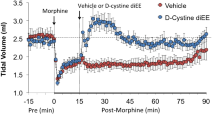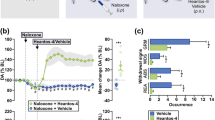Abstract
ADENOSINE-3′,5′-MONOPHOSPHATE (cAMP) has often been suggested as a second messenger which mediates the action of a variety of hormones1. The presynaptic location of the cAMP system, and the demonstration of a cAMP dependent protein kinase in mammalian brain tissue, suggest a possible role for cAMP in the central nervous system2. It has been suggested, for example, that cAMP may participate in the secretion of acetylcholine3 and the hypophyseal releasing factors in the hypothalamus3. In vitro4 and in vivo5 studies indicate that some putative neurohormones increase cAMP synthesis by activating adenyl cyclase. The effect of cAMP on brain biogenic amines has also been studied. Shein et al.6 showed an increase in serotonin (5-HT) synthesis from tryptophan by cAMP in pineal culture. Tagliamonte et al.7 reported that injection of cAMP into the lateral ventricle of rats increases the 5-HT turnover in brain. Results obtained in our laboratory in mice (I. K. H., H. H. L. and E. L. W., unpublished results) indicate that cAMP decreases the endogenous level of cerebral norepinephrine (NE) and dopamine (DA) as well as the conversion of 14C-tyrosine into 14C-CA (catecholamines).
This is a preview of subscription content, access via your institution
Access options
Subscribe to this journal
Receive 51 print issues and online access
$199.00 per year
only $3.90 per issue
Buy this article
- Purchase on Springer Link
- Instant access to full article PDF
Prices may be subject to local taxes which are calculated during checkout
Similar content being viewed by others
References
Robison, G. A., Butcher, R. W., and Sutherland, W. E., Ann. Rev. Biochem., 37, 149 (1968).
Miyamoto, E., Kuo, J. F., and Greengard, P., Science, 165, 63 (1969).
Breckenridge, B., and Bray, J. J., Role of Cyclic AMP in Cell Function (edit. By Greengard, P., and Costa, E.), 325 (Raven Press, New York, 1970).
Kakiuchi, S., and Rall, T. W., Mol. Pharmacol., 4, 379 (1968).
Chou, W. S., Ho, A., and Loh, H. H., Nature, 233, 280 (1971).
Shein, H. M., CIBA Foundation Symposium on the Pineal Gland (edit. by Wolstenholme, G.) (Churchill, London, 1971).
Tagliamonte, J., Forn, J., Perez-Cruet, J., Krishna, G., and Gessa, G. L., J. Neurochem., 18, 1191 (1971).
Way, E. L., and Shen, F. H., Narcotic Drugs, Biochemical Pharmacology (edit. by Clouet, D. H.), 229 (Plenum Press, 1971).
Shen, F. H., Loh, H. H., and Way, E. L., J. Pharmacol., 175, 427 (1970).
Maruyama, Y., Hayashi, G., Smits, S. E., and Takemori, A. E., J. Pharmacol., 178, 20 (1971).
Way, E. L., Loh, H. H., and Shen, F. H., Science, 162, 1290 (1968).
Author information
Authors and Affiliations
Rights and permissions
About this article
Cite this article
Ho, I., LOH, H. & WAY, E. Effect of Cyclic AMP on Morphine Analgesia Tolerance and Physical Dependence. Nature 238, 397–398 (1972). https://doi.org/10.1038/238397a0
Received:
Revised:
Issue Date:
DOI: https://doi.org/10.1038/238397a0
This article is cited by
-
Effect of dipyridamole on blood levels of opioid peptides and alpha-interferon
Bulletin of Experimental Biology and Medicine (1990)
-
Enkephalin regulates the levels of cyclic nucleotides in neuroblastoma × glioma hybrid cells
Nature (1976)
Comments
By submitting a comment you agree to abide by our Terms and Community Guidelines. If you find something abusive or that does not comply with our terms or guidelines please flag it as inappropriate.



